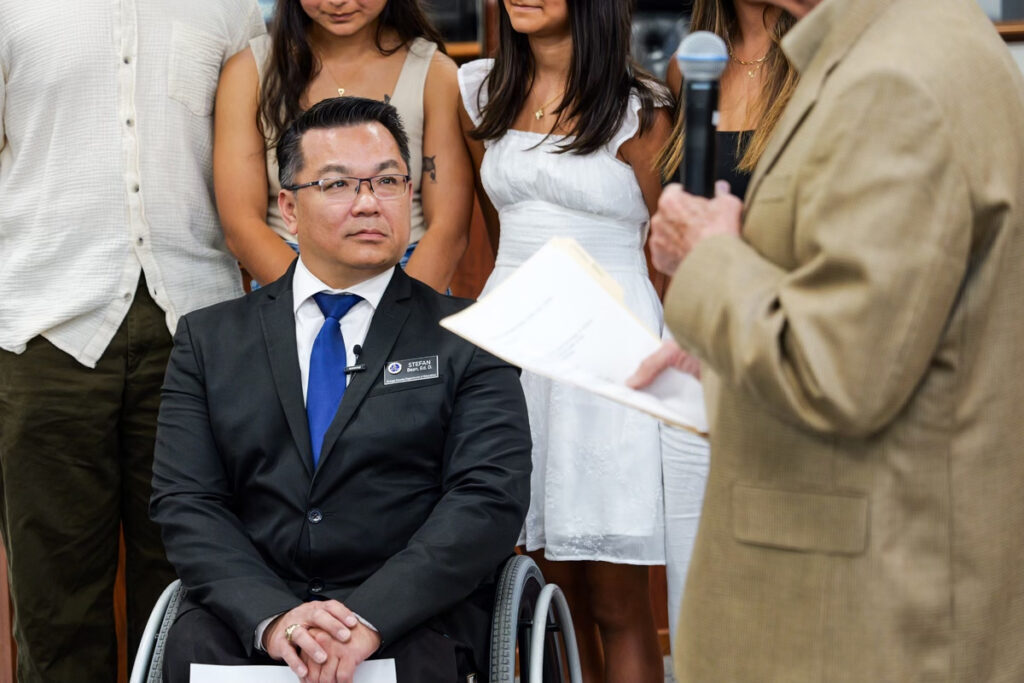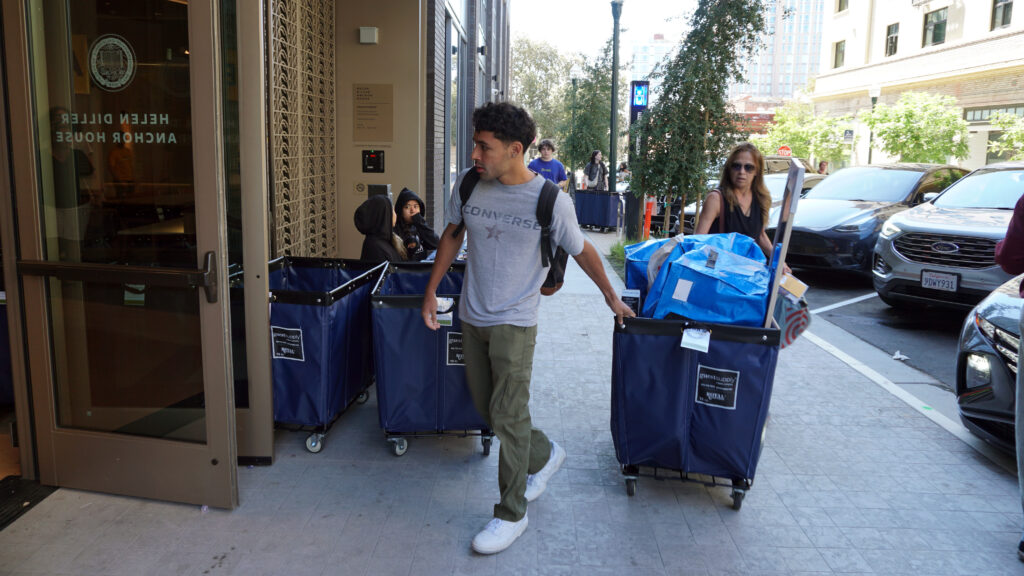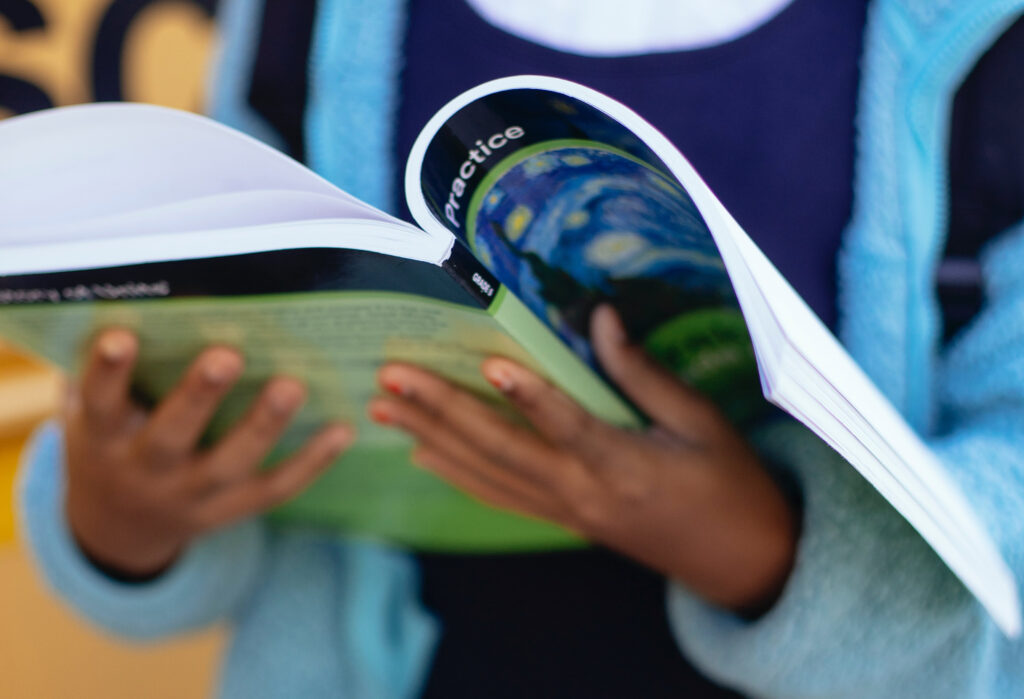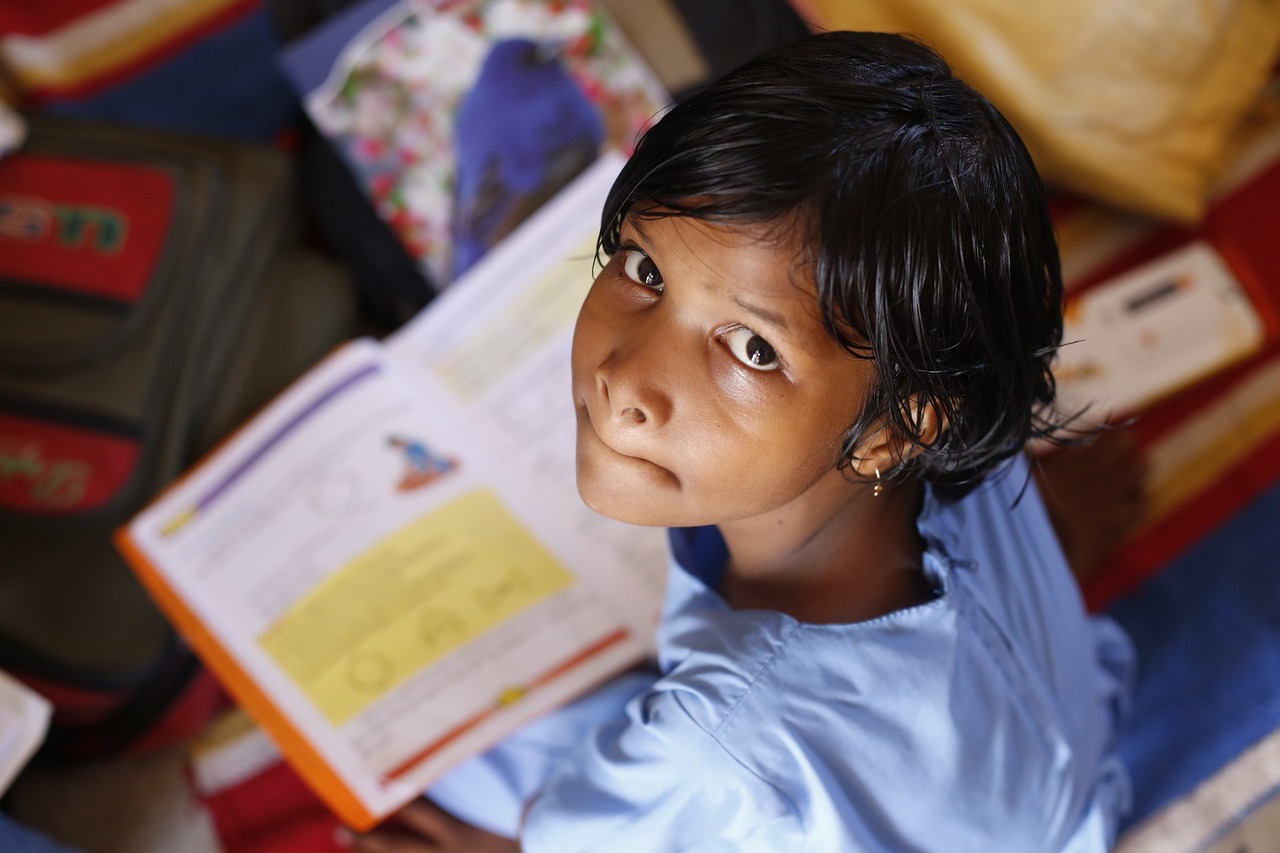
Allison Gamlen’s drama class forms a power circle.
Credit: Courtesy of Allison Gamlen
Allison Gamlen has always believed the show must go on. During the depths of the pandemic, when schools were shuttered and many children were suffering from fear and isolation, the arts educator fought to keep her students engaged.
When she realized some kids were turning their cameras off and playing video games during her Zoom drama class, she decided to hold some rehearsals in person, in the park. It was important to her that her students keep learning about the arts, but it was even more important to give them a space to connect. These outdoor rehearsals were entirely optional. Students kept their distance and wore masks, but they still found great comfort in that bond.
“It was a hard time for the kids, for all of us really,” said Gamlen, visual and performing arts coordinator for the San Mateo County Office of Education. “I just wanted to give them some people to connect with. I could cry right now just talking about how moving it was. We made a community, and I wanted to keep that community intact.”
Gamlen, a 45-year-old single mother, brings a chipper, can-do attitude to her work, particularly the need to be there for young people amid the escalating youth mental health crisis. Giving children a chance to voice their deepest, darkest feelings is at the core of the therapeutic powers of arts education. That’s a key reason Gamlen and other arts educators are cheering the advent of Proposition 28, which guarantees funding, roughly $1 billion this year, for music and arts education in TK-12.
“The need for arts education has never been greater,” said Jill MacLean, the director of American Conservatory Theater’s Young Conservatory. “I’ve witnessed many times over, especially these past few years, the transformative power of even the simplest theater-based experiences can be a lifeline to a child. For those who are struggling with anything from discovering their identity and interests to dealing with trauma – having a medium that celebrates uniqueness and grants permission to be creative while rewarding collaboration and focused effort – is exceptionally beneficial. The very foundation of acting is connecting to another human being, to share stories as a way to find meaning and relationship to others in the world.”
Like many in the teaching arts field, Gamlen is an educator, but she’s also an artist. She first fell in love with the theater at age 3 when her grandmother took her to a Japanese puppetry version of “Macbeth.” Some little kids might have been intimidated by the Scottish play, but she was entranced.
“I remember this intense feeling,” she said. “I remember the colors, red and black, and I remember feeling like there was no disconnect between me and the performers. I felt immersed in it, and it was so terrifying and so exciting and so unlike anything I had ever seen. I knew that was for me. That world.”
She cut her teeth as an actor and dancer. In addition to her work in the schools, she also teaches musical theater at San Francisco’s American Conservatory Theater’s youth conservatory. She also recently appeared in the company’s campy revival of “The Wizard of Oz.”
In traditional showbiz fashion, she paid her dues waiting tables, auditioning for parts and barely scraping by, until one fateful day in LA, watching her toddler, Anna, flap around the backyard in butterfly wings, tall green boots and a bug antenna. She found herself confronting the reality that she needed a stable income and health insurance to raise her child. Being a starving artist wore out its welcome.
“I couldn’t even go buy a cup of coffee. I had negative money,” she said, in a typical light-hearted quip about a heavy subject. “There were definitely times I was on food stamps, to be honest with you, for the early part of my life. Diapers alone will kill you.”
That day, Gamlen decided to move back home with her parents in the Bay Area, go back to school and pursue a teaching credential in arts education. Everything fell into place after that. She considers her current role as visual and performing arts coordinator for San Mateo County to be her dream job.
“Arts education access is a student right,” she said. “I love getting to work with students, teachers, and school leaders to improve student outcomes through increasing arts equity.”
That may be one reason Gamlen radiates optimism. While some in arts education circles have focused on the complications of implementing Proposition 28, which will put the arts back into classrooms after decades of cutbacks, she prefers to keep her eye on the upside. For example, there will soon be thousands of new jobs for arts educators, many of whom, like Gamlen, have long struggled to get by as artists.
“I am so stoked,” she said. “I know we’re hearing there’s a lot of questions and challenges, but it’s phenomenal. It’s so fantastic. So I can deal with the waiting. I can deal with the uncertainty.”
Like most arts educators, she sees her work as an avocation rather than a job. She believes in the power of the arts to elevate the educational experience and many say that commitment shows in her work.
“She is one of our newest and most active county arts leads and has made a great impression on me,” said Letty Kraus, director of the California County Superintendents’ statewide arts initiative. “She is very energetic and engaged in her work supporting arts education in her county, and very collaborative in her interactions and contributions to our network.”
She’s also a practical soul, often encouraging students to pursue media arts so they can snag a high-paying Silicon Valley tech job if they want to afford to live in the Bay Area.
“What makes Allison stand out, aside from her own skill set and artistry, is her keen interest in providing students with concrete tools they can take with them for their future experiences,” said MacLean.
There’s certainly a treasure trove of knowledge and nuance to be mined in a comprehensive arts education. Theater classes combine learning the craft of the actor with a deep understanding of how to best interpret the text. Actor training often taps into disciplines as diverse as history, literature and movement in order to make the leap from page to stage. If you are studying a scene from Athol Fugard’s “Master Harold … and the Boys,” for instance, you must take a deep dive into the legacy of colonialism, race and apartheid as well as the art of ballroom dancing.
“Allison’s knowledge about the process of acting, and her ability to break it down and make it accessible to young actors, is a gift,” said MacLean. “She understands the value of creating scaffolding to build a strong foundation when working with students. From a teaching standpoint, we are only as strong as our ability to effectively communicate the tools of trade.”
The lessons Gamlen hopes to impart go far beyond acting, however. She also hopes to help create a nurturing environment for a generation of students living through tumultuous times.
“It’s our job to create a safe space for them,” she said. “Students in this generation are living through the craziest times I can remember. I was there with them for that spooky orange sky day, and the insurrection and the inauguration too. The arts absolutely can be a place to process those things.”




















